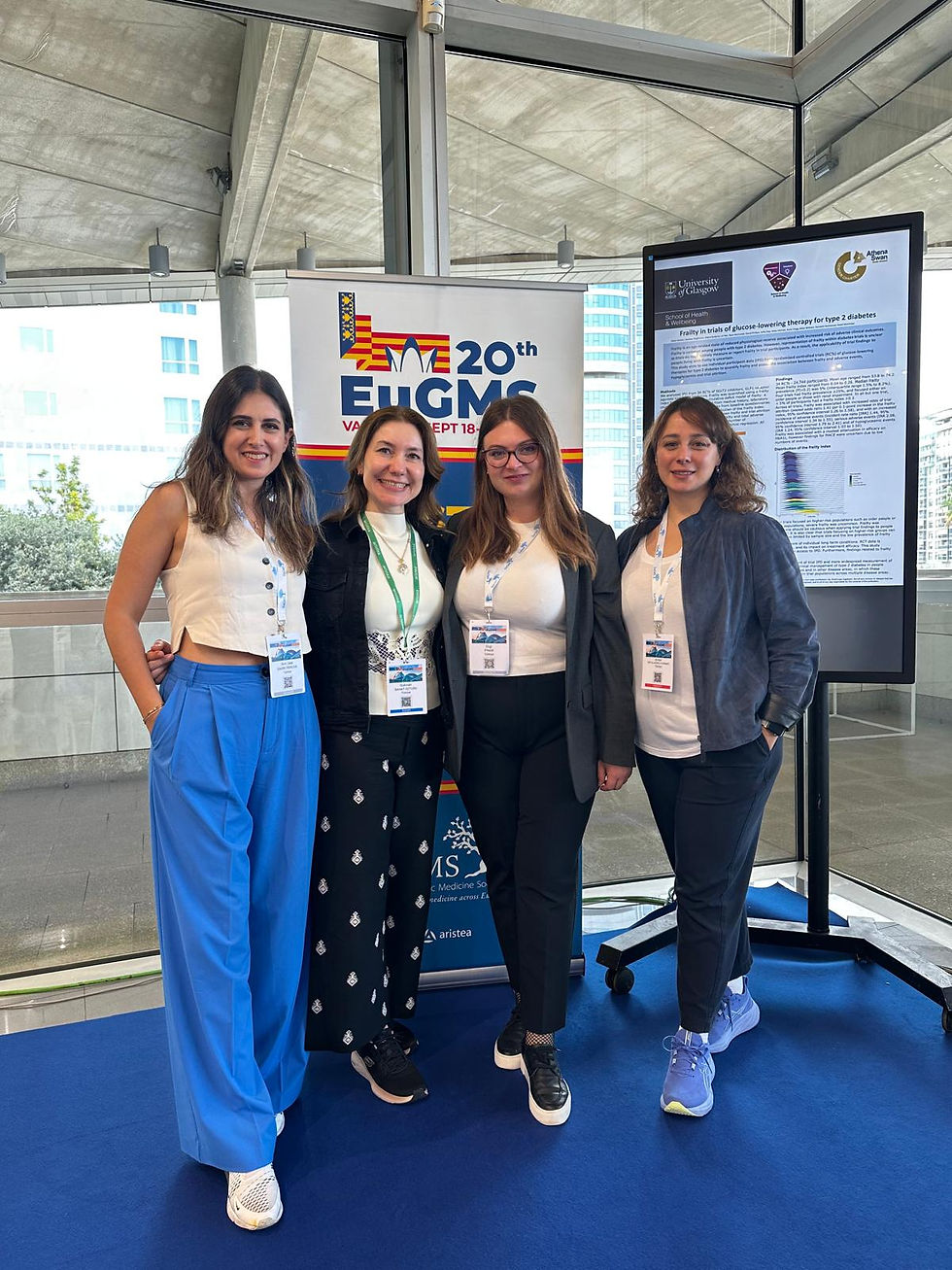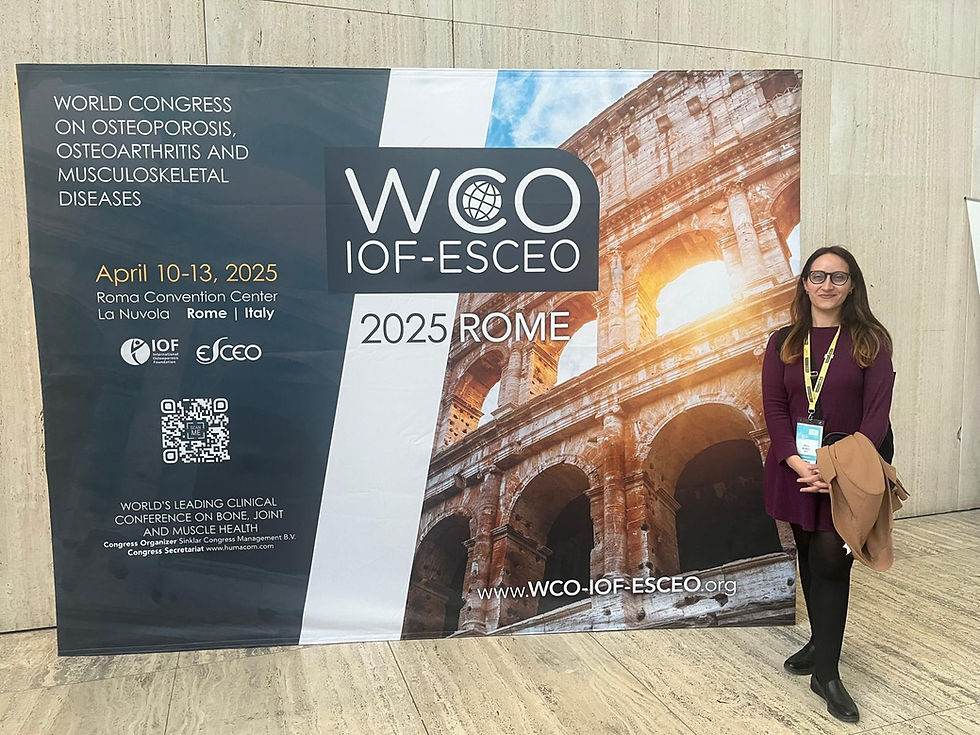“We Treat People, Not Just Organs”: A Conversation with Prof. Dr. Gulistan Bahat on the Present and Future of Geriatrics in Europe
- secretariat012
- Jul 2
- 6 min read
Authors: Zelal Sahin Tirnova & Ezgi Pinar
EuGMS ECGI Blog Working Group Leaders
Affiliation: Istanbul University, Istanbul Medical Faculty, Department of Internal Medicine, Division of Geriatrics
In this special ECGI Blog interview, we had the privilege of speaking with our academic liaison person Prof. Dr. Gulistan Bahat, a distinguished academician, clinician, and member of the EuGMS Academic Board. As one of the most influential voices in geriatric medicine in Turkiye and Europe, Prof. Bahat shared her insights on the essence of geriatrics, current research priorities, and the importance of global collaboration for early-career geriatricians. This conversation took place in May 2025, offering both personal reflections and strategic foresight on where the field is headed. The interview consists of six questions and will be published in two parts. Stay tuned!
1. What do you find most fascinating about geriatric medicine, and what aspects of this field do you think might attract younger physicians to pursue it as a specialty?
What I find most fascinating about geriatric medicine is that it allows you to treat the whole person, not just an organ or a system. You don’t simply manage blood pressure, blood glucose levels, or T-scores—you treat the patient in their entirety. From the very beginning of our medical education, we are taught that there are no diseases, only patients. In geriatrics, this principle is truly at the center of practice. You constantly consider the full picture: the heart, kidney, hormonal status, cognition, social factors, and more.
For example, when prescribing medication, you ask: Can this patient administer an injectable drug? Can they follow up regularly? These are vital questions. Geriatricians also take into account all the other medications and recommendations a patient might be receiving from various specialties. In many cases, those specialists might not be fully aware of what others have prescribed. This can result in drug–drug or drug–disease interactions, and if we fail to center the patient, we may cause harm.
We also have a principle in geriatrics: if an older patient develops a new or worsening symptom, always consider the possibility that it’s due to a medication. In one-third of such cases, that’s exactly the cause.
So, for me, the most fascinating aspect is this holistic, person-centered approach, which enables you to make a real difference in clinical outcomes.
As for why this field might attract younger physicians: first, you truly “help” people, often in complex situations like polymorbidity and polypharmacy. That sense of impact is incredibly fulfilling—after all, many of us chose medicine to help others.
Second, geriatric medicine is wide open for research. In many randomized controlled trials (RCTs), frail patients or those with multiple chronic conditions are systematically excluded. But we're now entering a new era where frailty is being acknowledged and incorporated into research. Although RCTs require significant resources, there are still many meaningful research opportunities—retrospective studies, cross-sectional studies, and studies on topics like sarcopenia, falls, and malnutrition.
Importantly, concepts from geriatrics—like frailty—are now being integrated into major clinical guidelines, including those for hypertension and diabetes. This is a testament to the growing influence of geriatric research. Young physicians who choose this path will find ample opportunity to contribute and shape the future of care for older adults.
2. Is geriatric medicine formally included in the medical school curriculum in European countries or elsewhere? In your view, what are the advantages and disadvantages for early-career geriatricians in Turkiye compared to their counterparts in other European countries?
Geriatric medicine is formally included in the medical school curriculum in some European countries, but not all. I can’t give an exact number or percentage, but there are publications that explore this in detail—particularly those from the Global European Initiative. One key reference is a study led by George Soulis, which I highly recommend for those interested in the broader landscape.
Countries like Spain, the United Kingdom, and the Netherlands tend to have more structured inclusion of geriatrics in undergraduate education. In Turkiye, geriatrics is included in the medical curriculum at some universities—but not the majority. While I don’t have exact figures offhand, I would estimate that roughly a quarter of medical schools offer dedicated geriatrics education. Again, I encourage colleagues to consult the relevant literature for precise data.
As for the advantages of pursuing geriatrics in Turkiye, I believe we are fortunate to have passionate, skilled geriatricians who are engaged in both high-quality research and clinical work. These dedicated academicians are truly committed to teaching and to raising awareness about the importance of geriatric medicine. This academic enthusiasm and mentorship environment can be a great source of inspiration for early-career physicians.
On the other hand, there are clear disadvantages as well. First, geriatrics is still not part of the core curriculum in many universities, and awareness among healthcare professionals in general remains limited. Many physicians—especially those outside academic centers—may not be familiar with the principles and scope of geriatric care.
Another challenge relates to the economic aspect. Geriatric medicine is generally not among the high-income specialties, especially when compared to more procedure-based fields like cardiology, gastroenterology, or surgery. This can impact career choices. While some opportunities are emerging—particularly in the private sector—the financial incentives for geriatricians remain relatively limited in Turkiye compared to other specialties.
Nonetheless, I believe that with time, as the value of geriatric care becomes more widely recognized, both educational integration and professional opportunities will continue to grow.
3. What are the current “hot topics” in the field of geriatrics at the global level? Which areas of research would you recommend early-career geriatricians to focus on today?
I’ve already touched on this briefly, but one of the most prominent topics today is sarcopenia—the loss of muscle mass and strength. It’s now widely recognized not only in geriatric medicine but also in other specialties, including oncology, surgery, nephrology, cardiology, and neurology. Sarcopenia has clear clinical implications in areas such as cancer treatment tolerance, postoperative recovery, and infection outcomes. Its recognition by other disciplines is an important step forward.
Closely related to sarcopenia are malnutrition and frailty. Frailty has become a key concept in geriatrics because we've learned that applying the same treatment strategy to frail patients as we would to robust ones often leads to worse outcomes, including disability and even mortality. Therefore, recognizing frailty and modifying care accordingly is critical.
However, frailty itself remains a grey area—we don’t yet have a universally accepted gold-standard assessment tool. There are various instruments in use, each with its own strengths, and they tend to be complementary. So one major research question remains: Which frailty assessment tool works best in which setting—clinical or research? This is an area ripe for exploration.
Malnutrition also stands as a major issue in older adults. While low muscle mass is a component of malnutrition, the issue goes far beyond sarcopenia. Optimizing nutrition is one of the most powerful interventions we can offer older patients, yet it's often overlooked.
Another critical domain is polypharmacy and inappropriate medication use. We know that even well-meaning physicians can cause harm when the patient's overall medication regimen isn’t carefully considered. Sometimes prescribers may not be aware of specific risks or interactions, especially when medications fall outside their area of expertise. This is where tools like the STOPP/START criteria come in—providing practical guidance for safer prescribing. There's a lot of room for further research here, especially in developing or validating tools that can be easily applied in busy clinical settings.
In fact, I strongly encourage early-career geriatricians to focus on practical, scalable tools for everyday use. For instance, while not all settings can afford detailed body composition analyses, calf circumference is a simple and accessible measure that can serve as a proxy for muscle mass. In my own career, I’ve tried to identify such pragmatic solutions, particularly in environments with limited resources.
Finally, we must not forget cognition. Topics like delirium and cognitive impairment are crucial but often underappreciated. These conditions significantly affect outcomes and quality of life in older adults.
Of course, identifying “hot topics” is somewhat subjective—what I see as a priority may differ from what another geriatrician emphasizes. But from my perspective, these are the areas with both clinical relevance and great potential for meaningful research.
📌 Stay tuned: The second part of this interview, covering the remaining questions, will be published very soon.







Comments